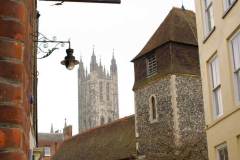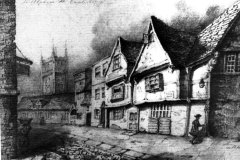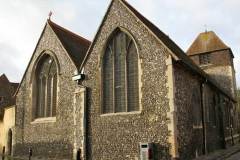Corner of Palace Street & St. Alphege
Introduction
St Alphege church occupies a prominent position in the city and is seen by many tourists and residents as they pass along Palace Street, but is now in the ownership of King’s school and not accessible by the public.
History
St Alphege was an 11th century Archbishop of Canterbury whom the invading Danes captured and held to ransom in 1011. He insisted that no ransom was paid so the Danes took him with to Greenwich, where they eventually killed him during a drunken rage by throwing ox bones at him. He was initially buried in St Paul’s Cathedral but translated to Canterbury Cathedral in 1023 and is now buried just to the North of the high altar.
The church was probably founded pre-Conquest in 1030 but was rebuilt around 1070 by Archbishop Lanfranc. The current tower and chancel date from the 13th century and the nave arcade and west window from the 15th century. In the 16th century Walloon and Huguenot weavers fleeing from persecution in France initially worshipped here. This quickly proved inadequate and in 1575 they moved to the larger Western Crypt in the Cathedral, where they were eventually granted a small chapel in perpetuity by Elizabeth I.
In the early 17th century Robert Cushman was married here. He allegedly negotiated the hire of the Mayflower on behalf of the Pilgrim Fathers at a cafe further up Palace Street. They sailed to America in 1620 and he followed the next year in Speedwell and is an ancestor of General Robert E Lee.
Photographs were taken by English Heritage of the interior of the church in 1942 and they can be found at the link below. The parish was merged with St. Peter’s in 1974 and became redundant in 1982, to become the Canterbury Urban Studies Centre and later the Environment Centre.
The church has a long association with Kings School, many of the pupils having being baptised, married or buried here. In 2007 it was acquired by the school and is now used for musical and dramatic events, lectures and examinations. It is also used as a music venue for the annual Canterbury festival.
What to see:
- The view from St. Alphege Lane with the cathedral in the background (Image 1), which has changed little since 1826 (Image 2).
- The view from Palace Street (Image 3).
Access: The church can be viewed externally at all times, but is not open to the public.
Sources: Lyle (2008)
SR



